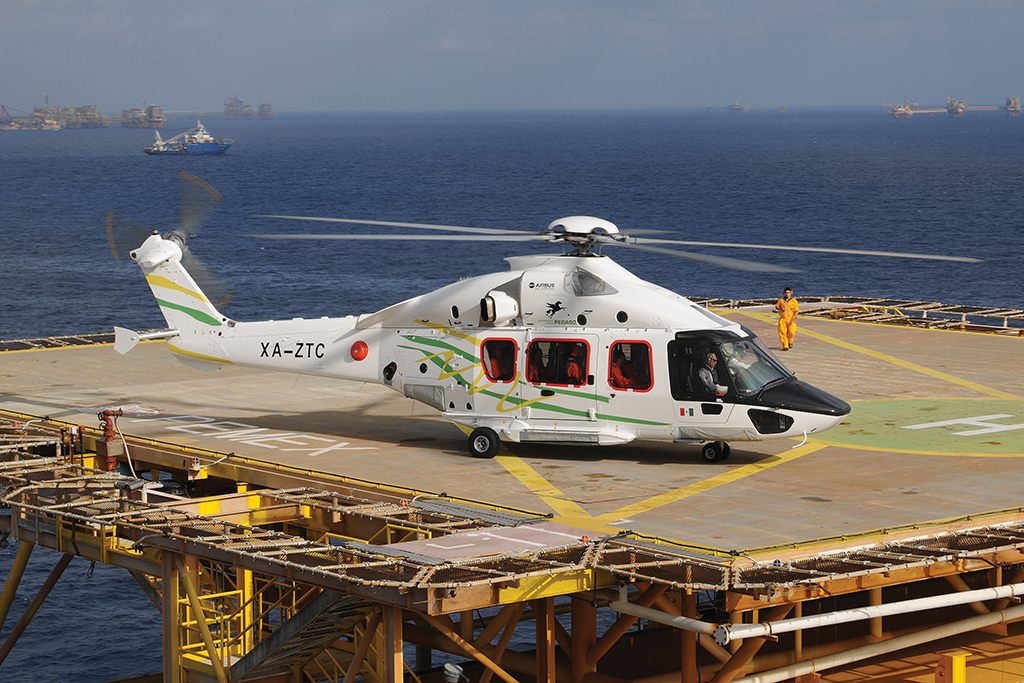
Leonardo’s AW139 secured eight orders from the offshore industry during Heli-Expo. The type is being used widely for offshore oil and gas operations.
If the rhetoric from this year’s Heli-Expo is anything to go by, the offshore helicopter industry may be getting ready for a spending spree.
A painful six-year slump in demand for offshore helicopters finally appears to be over, and across the world energy companies are reactivating offshore platforms and restarting exploration in response to record high prices and demand from governments for energy sovereignty and independence from Russia.
- Utilization rates are increasing for oil and gas platforms
- Hopes are high for a replacement wave of acquisitions
- Bell says its 525 could arrive in time to meet industry growth
Yet despite helicopter manufacturers’ optimism, operators placed just eight definitive orders for offshore helicopters when the industry gathered in Atlanta in early March. All were for Leonardo’s AW139 medium-twin, with two aircraft destined for Brazil’s Omni Taxi Aereo and six for United Arab Emirates operator Abu Dhabi Aviation.
It seems, then, that the industry is being cautious and disciplined about the next step. In 2008, the last time energy prices were this high, oil and gas operators were buying every aircraft they could secure—these were truly golden years for the offshore industry.
But when energy prices fell dramatically in 2014-15, the same operators were left with a glut of aircraft with little to do. The lease rates on those idle machines depressed operators’ bottom lines, which ultimately resulted in several major operators—including PHI, CHC and Bristow—seeking bankruptcy protection and restructuring. Their fingers burned, they relinquished loss-making leases, debts and fleets. But since that low point, operators have seen aircaft utilization levels steadily climbing with demand. Today, with energy companies clawing for more aircraft, supply has become taut.
Airbus’ figures confirm the progression: From 2019 to 2021, flying hours on its H175 super-medium platform increased 30% and rose a further 15% from 2021 to 2022, without any commensurate increase in fleet size.
A study by UK consultancy Air & Sea Analytics suggests that of the four aircraft types primarily used for offshore missions, all have utilization rates of more than 90%, with only a handful of inactive or uncontracted aircraft available.
“In the last few months, the industry and the operators are now looking very closely at whether to make new investments,” Gian Piero Cutillo, managing director of Leonardo Helicopters, told Aviation Week during Heli-Expo. “The whole fleet is flying, but this means there is a chance for replacement and for new aircraft.”
“The offshore energy services market is in the early innings of a multiyear growth cycle . . . but there is very little available capacity in the market now,” Chris Bradshaw, president and CEO of Bristow Group, one of the largest offshore operators, told investors. Bradshaw did say that the company had slots with OEMs that it could use for growth, as well as surplus Leonardo AW189s that are set to transition out of the UK search-and-rescue contract in the next few years in favor of smaller AW139s.
The case for the acquisition of new aircraft by oil and gas operators, therefore, appears to be compelling. But operators have found themselves squeezed in recent years by their energy company clients—the same companies that logged record-breaking profits this year.
“The oil and gas companies are setting a high standard. They are demanding high-quality products, high-quality service providers, high-quality operators with a local in-country value, but they’re squeezing us on the pricing,” Mark Pierotti, director of the commercial department at Abu Dhabi Aviation, said at Heli-Expo. “But this is the game and this is the challenge. We have to convince them that all these extras that they’re wanting are good for safety, good for operational ability—but there’s a cost to having it.”
Other operators have described this squeeze by the oil and gas companies as a race to the bottom, and it prompted operator Babcock to exit the offshore helicopter business altogether in September 2021. The company attempted to sell its North Sea offshore business to CHC, but the move was blocked by the UK Competition and Markets Authority last summer due to concerns that it could stifle competition. The Babcock unit has since been purchased by South Africa’s Ultimate Aviation Group, with the deal expected to close at the end of March.
Other factors operators are considering include the length of contracts and the ability to finance leases based on those contracts. Industry experts point out that some contracts have clauses that can end a contract after just 90 days, even if the contracted period is for five years. Lessors will be unlikely to finance the acquisition of new aircraft worth millions of dollars with such clauses in place. Some lessors have also found it difficult to attract financing from banks because of environmental, social and governance concerns and environmental perceptions of helicopter operations.

Yet the importance of offshore helicopter operations is clear. Hundreds of helicopters fly daily worldwide across long expanses of open water, delivering personnel and equipment to offshore platforms. If a system on the offshore platform malfunctions, the cost in lost production can run into the hundreds of thousands of dollars—and often it is a helicopter that comes to the rescue.
Sales of helicopters for the offshore market are lucrative for OEMs as well, often involving more complex, expensive large and medium platforms, but their usage rates also demand agile spares and support packages.
With lead times of 18-20 months for new aircraft, experts fear the wider industry could be “sleepwalking” itself into a helicopter shortage. They also predict that the industry will not only have to acquire new aircraft for growth, but also aircraft to replace aging fleets, particularly as some oil companies have tenders that call for increasingly younger aircraft.
The International Association of Oil and Gas Producers (IOGP) produces guidance for oil companies when tendering for helicopter contracts. The IOGP’s R690 rules stipulate aircraft equipment, performance and capabilities, but according to Air & Sea Analytics, about 44% of the aircraft in offshore service do not meet the R690 guidelines.
This could potentially drive a market need for as many as 800 new helicopters for the oil and gas industry in the next 10 years.
Airbus and Leonardo are well positioned for the potential growth with their H175 and AW189 super-mediums, respectively, which have already secured their place in the oil and gas market.
During Heli-Expo Airbus was close to finalizing an order from Rive Private Investment, a European transport investor and lessor for eight Airbus H175s, as the company sensed market potential to place them with oil and gas customers.
Some lessors have suggested that Airbus’ H225 could also make a comeback, particularly after the OEM announced the retrofitting of a new enhanced main gearbox for the aircraft.
H225s were largely eliminated from the offshore market after the April 2016 loss of one in Norway that killed 13 people, weakening oil worker confidence in the aircraft.
Meanwhile, as Bell moves closer to certification of its Model 525, the company believes the fly-by-wire rotorcraft may reach the market in the midst of an upward trend.
“We are seeing a significant response in demand,” Tim Evans, Bell’s director of 525 business development, said at Heli-Expo. “[Oil and gas customers] are really wanting to start getting serious about what’s next.”
The first batch of aircraft from the company’s Amarillo, Texas, production line will be configured for the oil and gas mission, although the OEM has not revealed who will take the aircraft.
Bell concedes the aircraft will be more expensive than other super-medium platforms but points out that its customers will be making a multi-decade decision with the helicopter and that it has a strong growth road map.
Sikorsky continues to produce its S-92 heavy helicopter, despite the closure of its S-92 production and final assembly line at Coatesville, Pennsylvania, in March 2022. Work on five aircraft is underway for search-and-rescue and VIP customers. The company used Heli-Expo to begin marketing the upgraded S-92A+ model with the modernized Phase IV main gearbox, a package of weight reduction features and a higher maximum gross weight capability of 27,700 lb. The OEM hopes to certify and bring the model to market in 2025.
Plans for a more advanced S-92B—equipped with Sikorsky’s Matrix autonomous flight technology and featuring a modernized airframe with larger cabin windows—drew limited interest from the market and were shelved.
